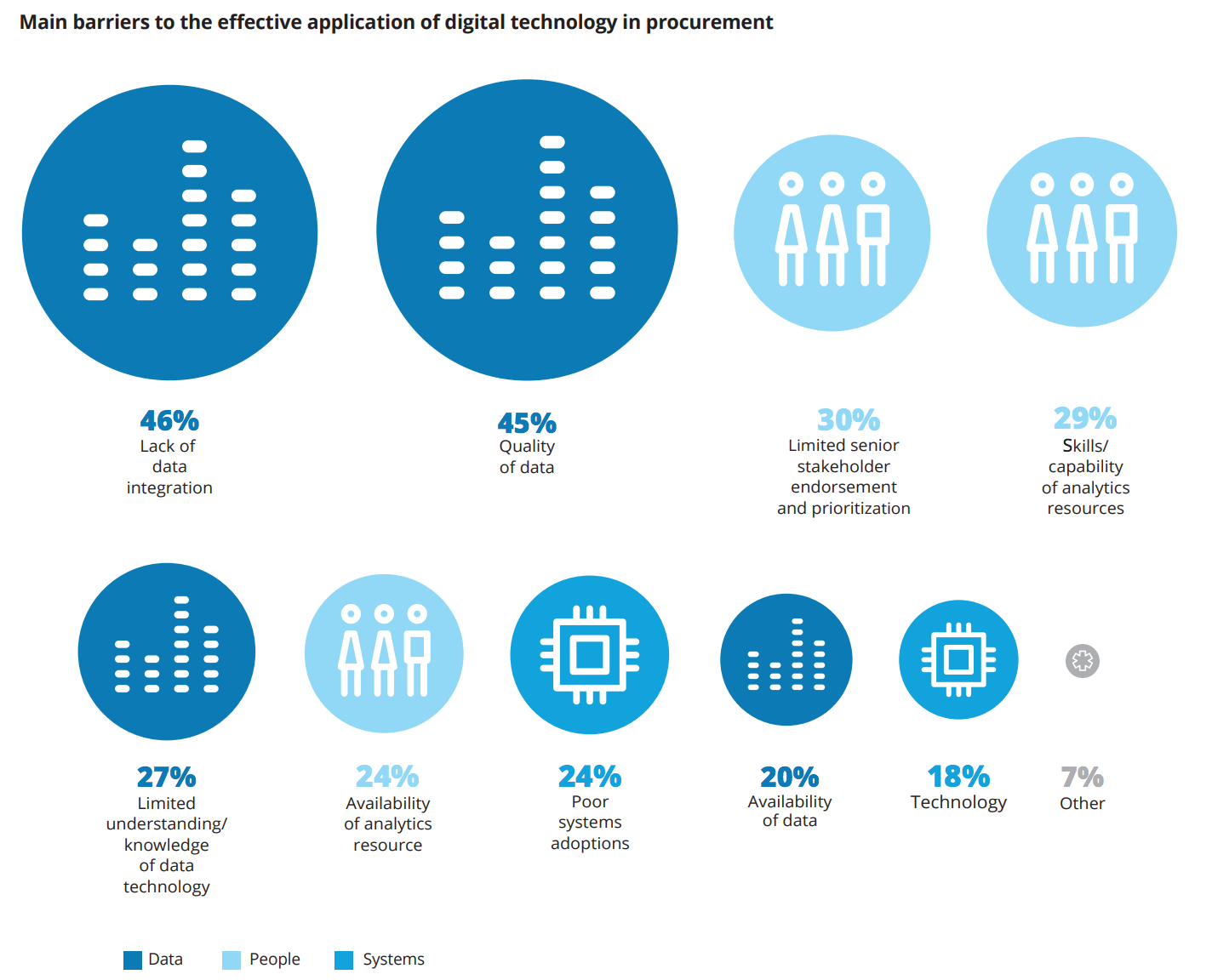Supplier Engagement: How Procurement Teams Can Learn From Marketing Automation
Procurement is a function, activity and role that is increasingly business critical to an organization’s overall value chain. In fact, many organizations are beginning to view procurement as a primary activity to increase top-line value and marginal growth.
Procurement is the glue between production, supply chain management, quality, sustainability, marketing and sales.
Unfortunately, the bond procurement is building between these functions is more like Elmers than Gorilla Glue — not very strong. All analogies aside, procurement’s traditional operations and a general reluctance to innovate within the function has created ceilings for organizational impact.
In 2019 to innovate, one must utilize and align all work tools and stakeholders at one’s disposal. This means procurement teams need to come into the digital age and adopt better digital technology.
But according to Deloitte’s 2018 CPO Survey, 5 barriers remain to strengthen procurement’s development within digital technology, and they are:

- Lack of Data Integration
- Quality of Data
- Limited Senior Stakeholder Endorsement and Prioritization
- Skills/Capability of analytics
- Limited Understanding/knowledge of data technology
Digitalization seems like a daunting task to some and this can breed skepticism amongst team leaders. But existing business systems and supporting solutions for procurement operations just aren’t cutting it any longer. Support technology in procurement could be considered a health and safety violation in some cases, considering the lack of user-friendliness.
How is it so that marketing and sales team get to have fun in the sun, prancing around with Mailchimp and HubSpot whilst procurement and supply chain teams are stuck under the umbrella slathering on sunscreen, trying to assess risk through Excel and e-mail? How can these functions be expected to build value in parallel to one another when procurement is running the race with sand in their shoes?
The barriers are clearly spelled out above. But understanding the root of the problem is simply the first step to creating a solution.
Different, But Very Much the Same
As much as I’m a procurement fanatic, I’m also a complete and utter marketing nerd. Marketing serves as a great example of a business function that has widely accepted the adoption of emerging technology to streamline overall performance.
As the story goes, in 1978 Gary Theurk, ‘Father of Spam’, sent out a mass email to promote DEC (Digital Equipment Corp) machines. Theurk sent 400 emails out through the Arpanet and “What would have then been a complete novelty for recipients (receiving a sales/marketing message direct to their computer’s inbox) resulted in $13 million worth of sales for DEC machines (and a few complaints!). From the start, email launched itself as an effective channel for direct marketing” (smartinsights.com 2013).
This was simply the birth of email marketing and as the years would pass, marketing software solutions became increasingly intelligent, and marketers developed strategies around the capability of technology. Flash forward to today and email marketing has evolved into the adoption of marketing automation platforms.
Marketing Automation Platforms or MAPs are “technology that manages marketing processes and multifunctional campaigns, across multiple channels, automatically” (Salesforce).
Of course, e-mail marketing is only one of the functionalities one can use for campaigning via marketing automation software, but it’s still — today — one of the most integral activities in an overall digital marketing strategy.
In fact, 82% of marketers in both B2B and B2C companies utilize email marketing technology (Ascend2 2018).
Running campaigns and monitoring campaigns are everyday activities for any digital marketer. Technology is the best means to take the initial workload off of the marketer, automate processes/reach, segment target groups and provide analytics for evaluation to improve future campaigns.
Even though it’s a different business function, procurement also relies heavily on emailing to be able to engage with suppliers, receive tenders for contracts, complete compliance measures within assessments, send out questionnaires or evaluations, edit agreements/negotiate, sign contracts, upload certification requirements etc.
So, why are procurement teams still stuck running operations from Office Suites, in Excel and e-mail hell?
Short answer: They shouldn’t be.
There are a plethora of solutions on the market that can help a procurement team automate supplier relationship management activities, streamline collaboration and gain analytics to further improve future operations. There’s a thing or two that procurement teams can learn from marketing automation.
Scalable Technology: Platformification of Procurement
CRM and Marketing Automation Platforms such as HubSpot, Salesforce (Pardot) or Marketo are robust platforms that allow a user (marketer) to customize their experience, centralize data and harmonize processes between various teams and data sets.
Platformification is going to be a big focus for technology vendors and should be for procurement teams in the new age of scalable technology.
Procurement, when practiced most impactfully, requires the alignment of various stakeholders in order to create value. Platforms are the launching pad for a team’s procurement rocket ship so to speak.
Collection of data is done at various touch points within a procurement organization in motion. Organizations have begun to apply innovative technology in the last few years to enhance capabilities of existing strategic and operational processes: RFI, RFP, Tendering, RFQ, Contract Management, Risk Assessment, Supplier Self-Assessment, Auditing, SPM, Spend Analysis and so on.
It’s time for these solutions and processes to align.
This will be made possible by technology vendors beginning to work within a framework of API-driven architecture. One-size-fits all solutions will be obsolete in the near future. Smaller, more agile, solution providers are entering the market on a daily basis to support the journey from Source to Pay. Luckily, platforms found in Marketing and Sales teams have created the blueprint for the creation of platforms in procurement.
API’s, while not the sexiest of technological topics, will be a big proponent of platformification. API (Application Programming Interface): “is a software intermediary that allows two applications to talk to each other” (MuleSoft). The ‘conversations’, API's have together, impact the solutions you use in your private life on a daily basis. When you download a game or post a picture to Instagram from your phone, API's are working in harmony to allow those actions; seamlessly communicating the threshold between the software’s processing systems.
Software solutions of the future will require technology vendors to work in tandem to other solution providers to build value. This will give procurement teams the opportunity to work with niche vendors that are specialists, work in more agile frameworks, and align those solutions with other work tools or existing business systems (ex. ERP Systems).
When I look at my MAP (Marketing Automation Platform), I can connect across various solutions, adding functionality and value into my overall operations and strategy. And that’s the real essence of scalable technology: added value.
Value, in procurement, encompasses far more dimensions in today’s world than it did once before, and our technology needs to reflect that.
E-Mail Marketing Methodology: Templates, Campaigns and Analytics
It’s time to focus in on an issue I briefed over earlier in this post.
I believe the current modus operandi of the majority of procurement organization’s supplier relationship management — supplier risk assessment and supplier collaboration — are incredibly time-consuming activities and have been living in Excel-hell for far too long.
Today, many supplier assessments (especially self-assessments) are still conducted through using Microsoft Office Suite. There’s nothing wrong with the office suite. I use it myself. For a lot of things. I’m drafting this blog in Microsoft word, right now. But, when it comes to the systematic risk assessment and management of suppliers, excel and mail just isn’t cutting it!
Procurement pros have a lesson or two to learn from Marketing Automation, but more specifically email marketing and automation.
Let’s break this down into the three pillars of e-mail marketing software functionality:
1. Templates
Easy-to-design templates of supplier assessments make emails easy to deploy across business areas, functions, countries, and time. This gives a procurement organization the agility to adjust questions depending upon the scope of the recipient, with ease. Also, it’s important to find a solution in which you can weight questions in your questionnaires or self-assessments. This way you’ll be able to utilize assessments as a systematic data-gathering touch-point with your suppliers, to create scorecards.
2. Campaigns
Deploying vendor assessments is best done in the format of campaigns. Each campaign should be treated as an opportunity to gather responses from suppliers at scale, and utilizing campaigns allows you to group supplier’s individual to the campaign’s purpose, specify categories of suppliers, and send out mass assessments; saving you time and a lot of headaches. Running campaigns also allows you to automate/schedule follow-ups and reminders to make sure that your suppliers engage with your governance documents.
3. Analytics
There’s no reason to send out assessments to suppliers if you’re not going to follow up the engagement of your supplier base’s responsiveness. The initial gauging of opens, clicks, and activity within an assessment will be crucial to ensure that your suppliers are willing to be governed, serving as the basis for compliance in the overall relationship management. Furthermore, the previous work put into the weighting of questions whilst designing of templates will render in automatic reporting of supplier performance at scale.
Mirroring e-mail marketing automation in your supplier assessment gives your procurement team an opportunity to automate a very operational task, whilst developing a strong foundation of insight for future strategic decisions.
Supplier Engagement Model: How To Get Opens, Clicks, & Replies
Now that we’ve read the first two ‘chapters’ (so to speak) of What Procurement Teams can Learn from Marketing Automation and we know what kind of platforms to look for, and some of the basic functionalities that we can look to mirror, we need some best practices for our supplier engagement strategy!
E-Mail Marketing and digital marketing campaigns, in general, are heavily dependent on the engagement of the target, prospect or lead. Is this all about luck? Or is there a science behind those special offerings landing in your spam mail?
Answer: There most certainly is, and the methods of email campaigning are well study, applied and tested, and ready to be applied within supplier assessments. Some of the best practices I’d like to share with procurement professionals, looking to enhance supplier-base collaboration and engagement with assessments, is how to get more opens, click-throughs, replies, and when is the best time to send.
Imagine you’re a master marketer. You have a product/service in the body of the email you want a prospective customer to see. What’s the first step?
Subject Line ! Subject LINE ! SUBJECT LINE !
Initial reactions are important, and the subject line of an email will be the first thing a recipient will see when an email lands in their inbox. As the old adage goes, ‘first impressions are everything’. So, let’s dress to impress and learn some best practices and strategies for upping the open percentage on your supplier assessment campaigns:
- Don’t be afraid to be mysterious: Creating a sense of mystery within a subject line never hurt anyone. Enticing interest and opens is all about curiosity. But, avoid being too obscure or unclear in creating curiosity. You still want the recipient to know what the email is all about, or it may seem like junk mail.
- Give a Time Limit: Letting the recipient know from the get-go that there is a specific amount of time associated with opening an email campaign may entice opens in a timelier manner. But don’t scare them off!
- Throw around your Brand Name: Sometimes throwing your organization’s name around isn’t the worst idea. If you know that there is a grouping of suppliers that will see your company’s name, and open the email, well: do so!
- Create Action: Action verbs in subject lines tend to create a sense of urgency, which often results in better open rates.
- Don’t be afraid to have fun with it: As you can see in the example listed above, it’s not the worst thing in the world to have a bit of fun with your subject lines. These are still human beings on the other end, treat them like it!
- Numbers don’t lie: Using numbers in your subject lines can elicit opens, but don’t use numbers if they don’t belong!
- Play to emotion: Play to their emotions, whatever those may be! Making the recipient feel special never hurts.
- Language can factor in: If you’re sending out to a grouping of suppliers in Vietnam that you believe may have a language barrier, send the assessment in their language. Translations can be costly, but the response rate will pay in dividends.
Subject lines will be integral in getting opens and a great way to make an initial first impression on your supplier.
So.
Now they’re inside the email, how do you make sure that your suppliers engage with your material?
Well, the body needs to really kick butt! CTR (click-through-rate) will be a clear indication of how many responses you’ll receive in supplier assessments.
Here are some quick tips for getting better click-throughs on your material:
- Use Images: In the body text of your email, you should take the opportunity to import images. This will make the text more interesting for the reader and should create a direct association with your brand.
- Be descriptive, yet concise: Telling the supplier exactly what you want will result in a higher click-through-rate. There’s no reason to beat around the bush. You’re looking for them to fill out the supplier assessment that is linked to the email, so let them know your intentions from the start! It’s important to communicate expectations and deadlines in your initial email.
- It’s a conversation: Remember, you’re writing these emails in order to receive a response. Even though you’re looking for the recipient to engage with your assessment, your email shouldn’t be a mandate, it’s a conversation.
- Copywriting is important: Think about the structuring of your text. Is it easy to read? Is it interesting to read? Does it get across my expectations? Put some thought into how your email may be perceived by a recipient. Don’t be afraid to use varied punctuation, bullet points, headings etc.
Now that the supplier has clicked through on the assessment, it’s important that the interface of the questions is engaging. This will result in the best results as far as assessments answered.
Something that Procurement teams can look to gain from their technology that is a pivotal part of marketing automation is the ability to schedule multiple campaigns and can provide tracking and analytics of the supplier engagement. This way you’ll be able to automate the bottom-line activities involved in campaigning, strategize and develop conditions for future campaigns based on conversions, and locate suppliers in the top/bottom compliance-brackets: quickly.
When it comes to campaign strategies, there are some best practices as far as sending best practices and methodology.
- Frequency/Scheduling for Automated Sending: Sending four emails in the span of one month will create a higher open rate, considering you will have multiple touchpoints with the same perspective opener (WhoIsHostingThis).
- Best days to send emails: Tuesday is the number one day for opens, then Thursday and third in rankings is HUMP DAY (also known as Wednesday)!
- Best times to send: Campaigns receive greater engagement depending on the time the campaign is received (local time to the recipient); 10 AM is the optimal time for send outs and behind that is 8 PM considering people typically check emails before bed (CoSchedule)!
Want to learn more? Check out our article on 5 Ways To Spark Supplier Engagement: Making Vendors Into Partners.
Now that we’ve mastered some of the basics, and have received our white belt in email/marketing automation and campaigning, it’s time to talk about the benefits for your procurement team!
Benefits of Adopting These Methods/Technology
Traditional methods of collaborating and interacting with suppliers are not agile, considering the growing demands on procurement organizations to digitalize their processes and develop deeper transparency and trust with their supplier-bases.
The adoption of cloud-based platforms in marketing has allowed organizations to utilize multiple work tools within the same interface, interact within global teams, creating better cross-functional collaboration and better reach to potential prospects. Marketing is a function that has realized the value of technology; the link between people and collaboration/engagement at scale.
Procurement teams can reap the same benefits but need to be willing to adopt new operational and strategic tools.
There are a lot of benefits that have been studied from adopting marketing automation platforms, and some of those same potential benefits hold true for procurement teams:
- Improve accountability of your internal team: Creating a systematic framework for procurement related activities within a digital platform will allow managers to quickly locate which strategic purchasers/category managers are managing their supplier-bases properly, and which need to develop.
- Reduce staffing costs: This one is pretty straight-forward: less hands-on operational procurement activities will require fewer bodies to do so. Then again, it’s important to look for new hires that have a high digital competency, and traditional procurement skillset, to be able to take on new roles within your organization directly tied technology.
- Ability to become more creative in your risk management: Going back to the example of designing a supplier self-assessment, breaking out of the confines of Excel and utilizing a digital solution could allow you to have more elaborate questions/get creative with the scoring of suppliers’ answers; individual to your business-critical needs and procurement goals.
- Refining your processes: Working within the limitations of a digital platform can be a good thing. Over-complication of procurement processes can be the downfall of a procurement strategy.
- Automate/Schedule daily activities: Scheduling and automatic notifications/actions will take away from the stress of planning future supplier-related activities.
- Scoring & Reporting: Increasing your data entry points will allow your team to gather supplier insights quicker, which will help you more strategically allocate spend and leverage supplier competencies.
What Can We Take Away?
Directly mirroring a MAP will not give you a better solution for, sourcing, managing supplier relationships and driving performance 100% of the time.
Ultimately, you need to take a look at your existing processes, and determine where your organization is today, and what you can realistically set as digitalization goals. Find solutions that can help automate and streamline existing modes-of-operation and gain better insights in the meantime. This may mean that the information in this post doesn’t match your operational or strategic goals exactly, but that’s ok!
In the end, you need to decide how technology will help create shared value for your organization, partners, shareholders, stakeholders and society at large.
Until next week.














